LinkedIn is a professional networking and career development website that real estate agents can use to make connections, establish their online identity, and generate business. By learning how to use LinkedIn for real estate, creating a captivating profile and posting real estate-related content will provide steady brand recognition. Also, by using paid advertising and nurturing your online connections, agents can target online reach that yields real estate opportunities.
1. Build a Compelling Personal LinkedIn Real Estate Profile
A LinkedIn realtor profile acts as a landing page for your brand. Agents who want to generate real estate leads should have a page that clearly identifies their profession through a professional headshot, headline, and profile summary.
Ensure that people visiting your page understand what you do and your services. I recommend agents consistently update their profiles to ensure prospective clients have the most accurate information on where they work, some of their most recent projects, and their newest acquired skills.
A headshot is one of the first things people will see in LinkedIn search results, search engine results, and when they land on your profile page. Unlike other social media pages, LinkedIn profiles should be created to build immediate trust and put your best foot forward with prospective clients on this professional platform.
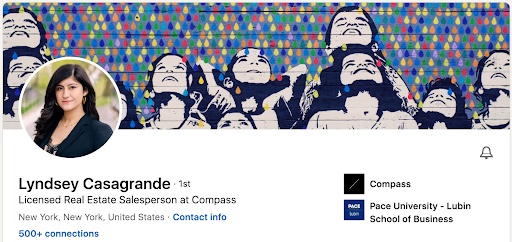
LinkedIn member profile example (Source: LinkedIn)
Make sure your photo is cropped enough to see your face clearly, as you’ll want prospective clients to recognize you offline and through other real estate marketing efforts. Profile images should fit the LinkedIn image parameters of 400×400 pixels and be high-quality photos. Agents should market themselves in their profile with as much detail as you would put into marketing your listings.
The professional headline sits just below your headshot. It consists of 120 characters of opportunity to share your marketing message, promote your services and brand, and share your expertise. By default, your headline will be populated by LinkedIn to show your current job title and employer.

Eye-catching real estate agent profile headline example (Source: LinkedIn)
The best LinkedIn headlines will showcase your value proposition. It should catch the attention of people breezing through multiple profiles online and encourage them to stop and take a closer look at your page. It should be written to address your target market directly. If an agent specializes in representing buyers interested in luxury properties, their headline should address those buyers and establish credibility to represent them.
The profile summary section is located beneath your headshot and headline. It’s an opportunity to describe yourself and your expertise in long-form, up to 2,000 characters. Successful real estate agents will use this area in LinkedIn for real estate marketing instead of using a generic biography to take up the space.
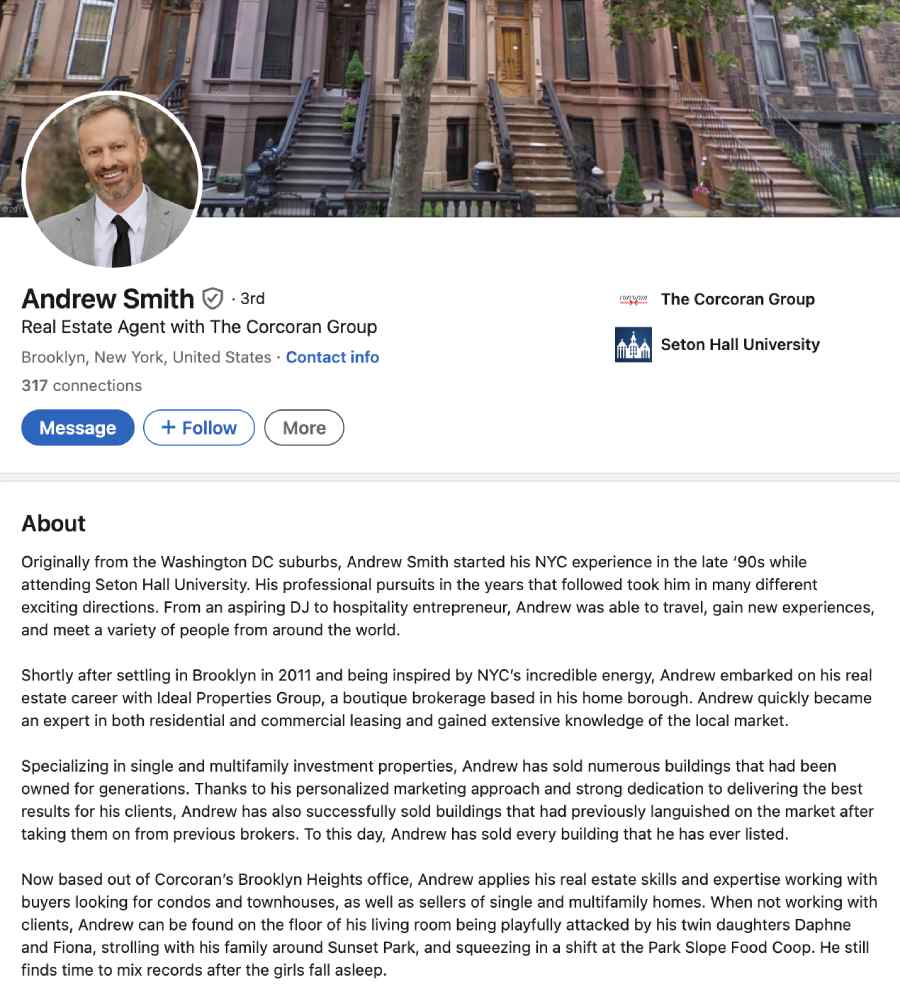
Profile summary example (Source: LinkedIn)
We suggest showcasing your personality, summarizing your most significant achievements, and/or explaining your career choices with some context. This section is meant to strengthen a first impression that may not be conveyed in your profile’s experience or education sections.
When creating a LinkedIn profile, each user will get a profile Uniform Resource Locator (URL) “https://www.LinkedIn.com/in/” followed by your name and maybe some numbers. A LinkedIn URL should reflect your brand and can easily be your full name. However, if your name is long or uniquely spelled, changing this URL can help others find your profile easier, allow others to share it easily, and can be used professionally for email signatures and marketing materials.
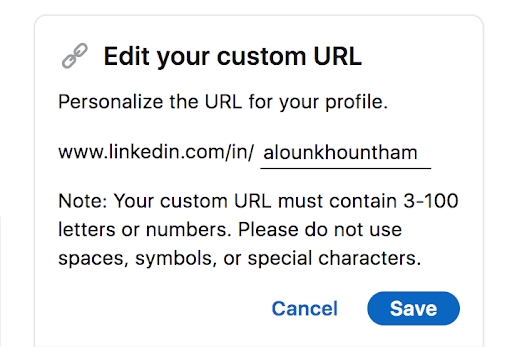
Editing custom profile URL (Source: LinkedIn)
2. Create a Business Profile
Real estate agents must have a business profile and a personal profile on LinkedIn to give credibility to the products or services offered. Business profiles or company pages are similar to personal profiles—but highlight the business’ expertise, services, employees, and accomplishments. This strategy will increase additional exposure to your business because an additional landing page is created, and more tools are provided to increase page following and engagement.
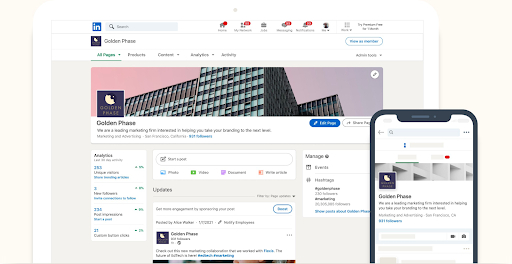
Business profile example (Source: LinkedIn)
Grow Your Audience
On a business profile, LinkedIn for real estate agents can further develop their brand’s marketing messages and grow a business following, whereas, on a personal profile, you’re limited to personal one-on-one connections through your network. For example, on a personal profile, only those connected to you in a 1st-, 2nd-, or 3rd-degree connection can see your profile or even invite you to connect, while, in a business profile, anyone can choose to follow you.
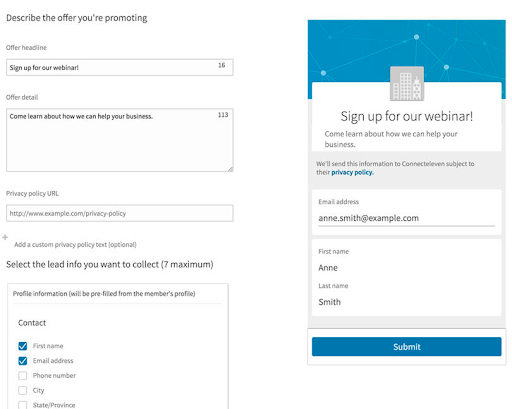
LinkedIn lead generation form (Source: LinkedIn)
Adding a business profile gives you access to lead conversion tools, like adding a lead generation form to your page. The form allows visitors to leave their contact information on an auto-filled form that pulls in information. Agents can use these forms to collect contact information when hosting informational seminars or for those looking to learn more about your services.
Increase Community Engagement
With a company page, you can engage with your page followers and your team to attract prospective clients. Engaging with your followers through LinkedIn Live Events can attract the right type of audience to promote your business. These events are streamed online and provide opportunities to connect individually with attendees. Agents can collect leads from registration forms and promote the event to reach a larger audience.
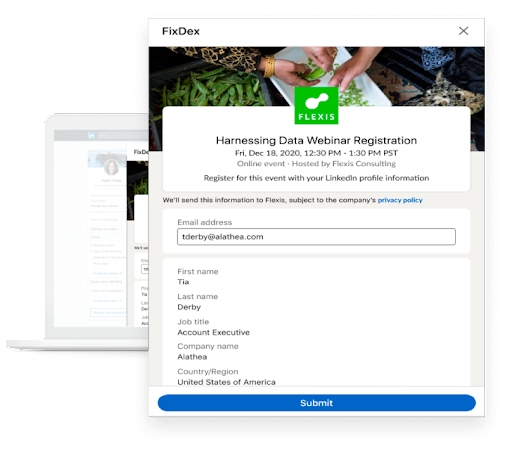
Event registration form (Source: LinkedIn)
3. Increase Your LinkedIn Real Estate Professional Network
Seventy-nine percent of American professionals believe in networking as essential to career progression. However, collecting LinkedIn connections won’t just result in success for your business. You have to make connections that are beneficial to your business. On LinkedIn, connections are made when you or someone you invite to connect accepts the invitation.

LinkedIn connections illustration (Source: LinkedIn)
There are different levels of connections on LinkedIn, the degrees of which are the following:
- 1st-degree: These are LinkedIn users who have accepted your invitation to connect, or you’ve accepted their invitation to connect. These users will have a 1st-degree icon next to their name in search results or on their profile. You can send direct messages to 1st-degree connections on LinkedIn.
- 2nd-degree: These users are people who are connected to your 1st-degree connections. They will have a 2nd-degree icon next to their name in search results or on their profile. Connect to these users using a connect button via their profile page or in search results.
- 3rd-degree: These are LinkedIn users connected to your 2nd-degree connections and have a 3rd-degree icon in search results or on their profile page. You cannot connect to these users directly but can message them via InMail. You will often only see a reduced profile for 3rd-degree connections unless you have a premium LinkedIn account or share a LinkedIn group connection.
- Followers: These are LinkedIn users who choose to follow your public updates that show up on their LinkedIn feed.
2nd- and 3rd-degree connections and followers are opportunities to become your 1st-degree connections. To connect with 3rd-degree connections, find someone you have a mutual 2nd-degree connection with and connect with them to make the 3rd-degree connection a 2nd-degree connection. Then, you can connect directly with the 2nd-degree connections.
4. Leverage Your Sphere of Influence
A sphere of influence (SOI) is a list of professionals you know personally and professionally. They can provide you with business opportunities by sending a referral, helping market your services, or can give you direct contacts. Often, people in your SOI will be family, friends, colleagues, past clients, or even neighbors.
Because these SOI relationships can be personal, many people exclude these connections for fear of intermingling personal and professional relationships. However, having access to their connections allows you to create a more extensive network by having someone in common to help with referrals or introductions.
An easy way to increase your LinkedIn network is by importing the Gmail, phone, and email contacts of people you have corresponded with. This process will upload your address book contacts and allow you to connect with the contacts on LinkedIn, suggest relevant connections, and show you updates of imported contacts.
The following steps can be taken to sync your contacts to LinkedIn:
- Go to Account settings
- Click Account preferences
- Look for syncing options and select sync contacts
- Select which contact sources you would like to sync with
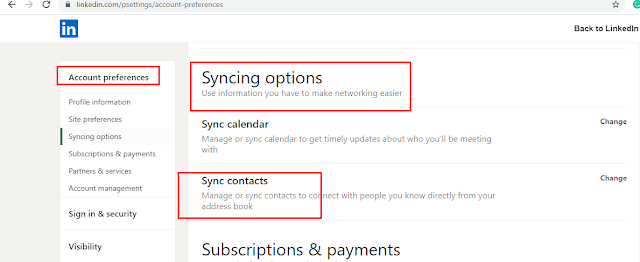
Gmail, phone, and Outlook contact syncing options in LinkedIn (Source: LinkedIn)
Instead of manually adding contacts or trying to search individually for new contacts, this import process will periodically sync with your address book, so any incoming leads to your inbox or contacts will be shown to you. But this process does not automatically make connections for you—you must manually send an invite to connect.
The LinkedIn’s People You May Know (PYMK) feature recommends new prospective connections based on shared connections, similar profile information, similar location, similar work experiences, or similar education at the same school. Find this section under your My Network section at the top of your LinkedIn screen. However, the PYMK section is usually under your current invitation section.
To add messages to an invitation, follow the following steps:
- Go to the profile of the users you want to connect with.
- Click the “Connect” button under their location or hit the “More” button on 3rd-degree connections.
- Click “Add a note.”
- Enter your personalized message in the provided field.
- Click on “Send invitation.”
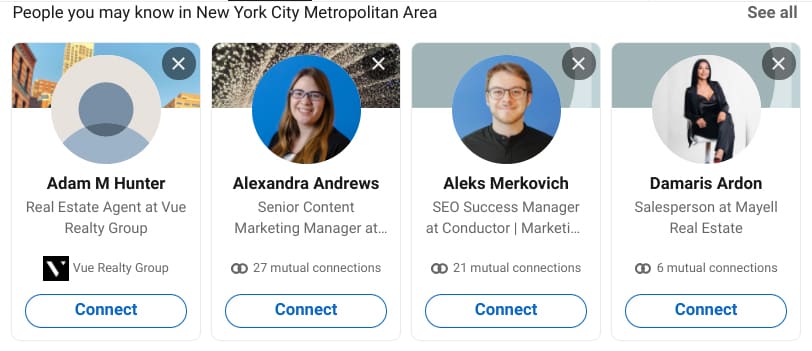
People You May Know section (Source: LinkedIn)
You can directly connect with those listed in the PYMK section by clicking the Connect button. Within the PYMK section, you can withdraw an invitation if the user has not acted upon the request. You also can remove suggested connections with the “X” located on the upper right next to their image. Include a personal message to increase the probability of users accepting your initiation.
LinkedIn groups are an opportunity to connect with other professionals with similar interests or professions. Once you join a group, have conversations and message other group members to make 3rd-degree connections. Real estate agents can join LinkedIn real estate-related groups with other agents or users interested in real estate and could contribute to the conversations.
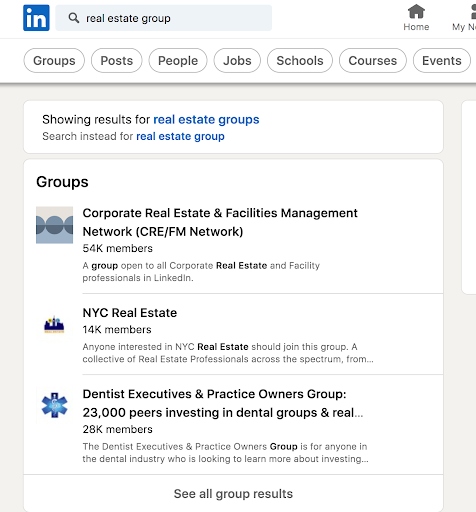
Real estate group search results (Source: LinkedIn)
Select the group you’re interested in to see its profile page. On the profile page, you can see the group admin, information about the group, the join button, and hashtags associated with the group. Many groups allow anyone to join, whereas other exclusive groups require admin approval before joining. Strategically position yourself in professional networking groups by actively participating within the group to illustrate your knowledge and expertise.
5. Define Your Niche & Set Goals
LinkedIn for real estate lead generation should be treated like any other marketing tool. The best use of your marketing effort should help you stand out from your competitors and position yourself as an expert in real estate.
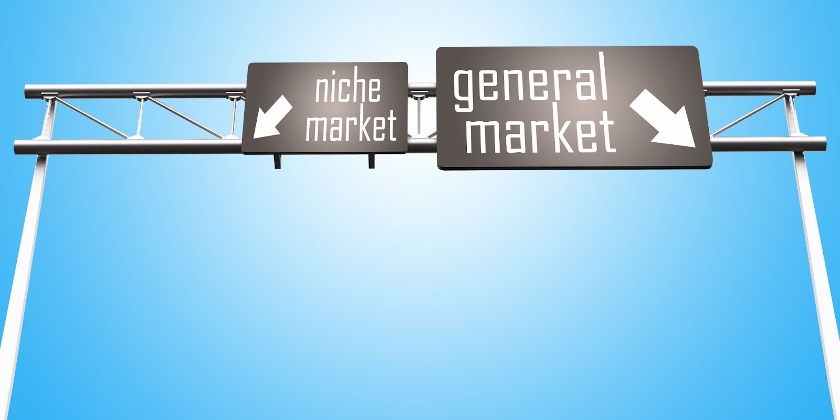
To do this, agents should always have a defined real estate niche to maximize and clearly define their marketing efforts. A real estate niche can be based on location, activity, property type, or situational, which can be leveraged on LinkedIn to connect with prospective clients with similar interests or goals.
Use LinkedIn Hashtags
One way of locating user interest is by finding hashtags that match topics relevant to your niche. For example, if you specialize in vacation rentals or have a property near a busy vacation area, search “#vacationrentals” in the top search bar, and you will find LinkedIn posts with that hashtag. Read through the posts and see if a user has a question or need you can assist with.

Vacation rental hashtag (Source: LinkedIn)
Instead of searching for an individual hashtag every time you log into LinkedIn, follow certain hashtags by clicking the follow button under the hashtag after you search for one. This allows posts with the hashtag to show up on your feed. Additionally, use a hashtag on your content by clicking “add hashtag” when creating a post so others searching those keywords can find your content. Hashtags on your post can spark conversations, reach users who share your interest, and establish your credibility on a topic.
Scope for Prospective Clients
Many companies use LinkedIn for their business development efforts. Agents can use the platform to search for prospective clients in their niche market. For example, if you operate in the Palo Alto area, you would want to connect with professionals in that location. Many professionals would also work in tech or finance for companies headquartered there, like VMware or Palantir.
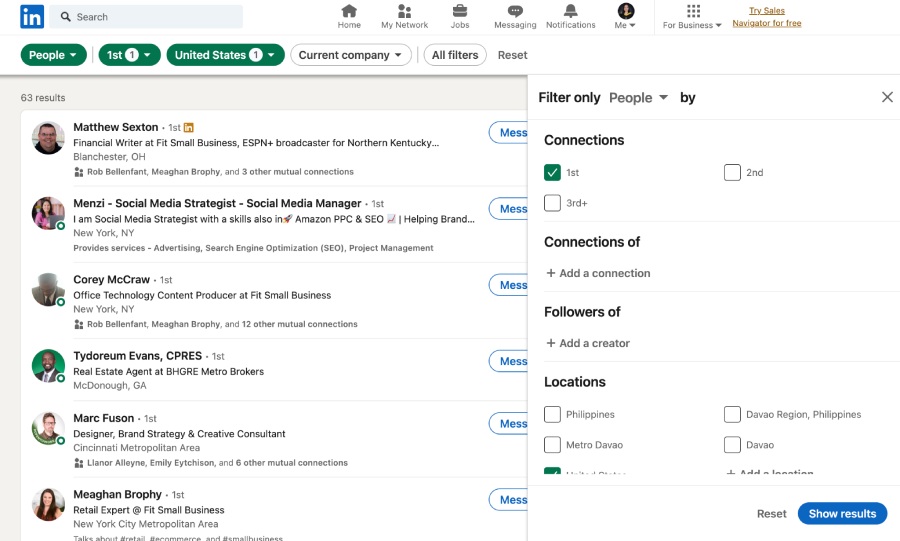
People search filters (Source: LinkedIn)
To scope for connections that fall into your niche category, process a search in the search bar using location and company, then narrow your search results by items relevant to you. Make sure you narrow your search results to “People” instead of “Jobs” or “Groups” to see users you can connect with. Under all filters, select a relevant hashtag and identify keywords or language listed on the profile. All these filters help agents narrow down users who may be most relevant for business development opportunities.
6. Post Real Estate Content
Real estate agents can create different LinkedIn real estate posts, like videos, documents, article links, or plain text. Posting relevant content establishes your knowledge and credibility of real estate. When others see your posts and see them often, there is a greater chance to start a conversation and develop better connections with relevant and like-minded users.
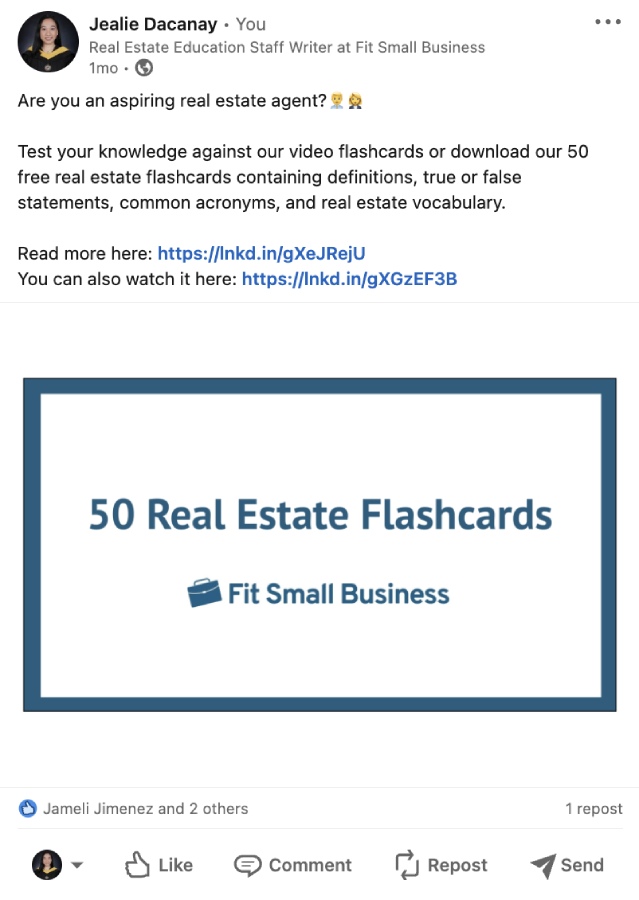
LinkedIn real estate content post example (Source: LinkedIn)
When users “like” or “share” your content, that post will show up on your 2nd-degree connection’s feed, and there is an opportunity for a new lead to see your content and prompt them to connect with you. Therefore, agents must constantly post so that you increase the likelihood of creating more interactions with the network. Like social media marketing, agents should create a content calendar to help them consistently post on LinkedIn.
Create Quality Content
Social platforms will filter how your content appears to social media users by using an algorithm that determines the relevancy of your content to each user. These algorithms will affect your post’s performance and its reach. The LinkedIn algorithm will rank and filter your content to determine its quality and display it accordingly. If your content engages with likes, views, comments, etc., to a sample of your audience, it will continue to display your content to a broader audience.
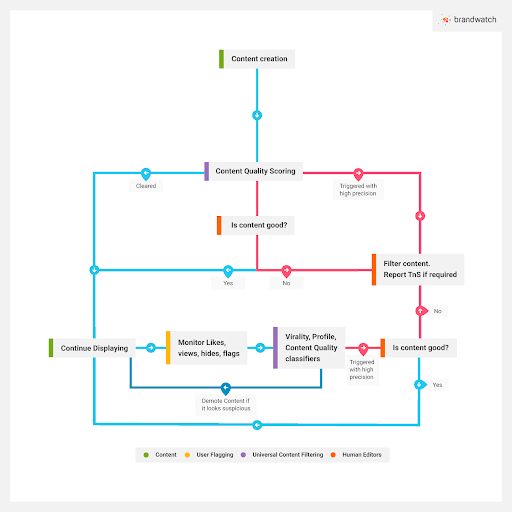
LinkedIn algorithm chart (Source: Brandwatch)
With knowledge of how the algorithm works, users can modify their content so it is shown to their desired audience. There are some tips to ensure your content is not flagged as spam. Following these best practices will ensure your content stays available to other users:
- Make your content relevant: The biggest red flag is if other people mark it as spam, hide the post, or ignore it altogether.
- Avoid grammatical mistakes: Agents should always use correct grammar and punctuation.
- Limit tagging of other users: Do not tag more than five other LinkedIn users in a post.
- Space out your posts: Don’t post more than every three to four hours.
- Reciprocate content engagement: This ensures other users feel comfortable engaging with your content.
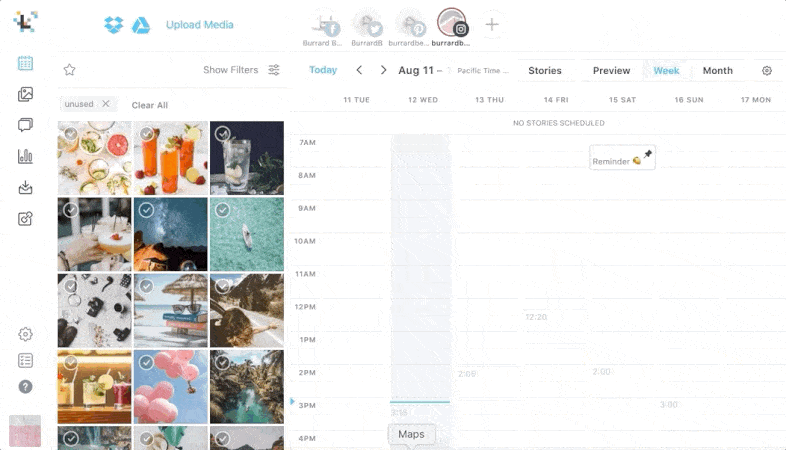
GIF of adding a social profile to a calendar (Source: Later)
To help with LinkedIn real estate posts, platforms like Later support social media management—integrating with social platforms like LinkedIn and Facebook. The platform lets you create and schedule posts in advance, and it will automatically publish the content on your behalf. The presence of a mobile application enables you to manage your posts on the go without needing to transfer media between devices.
Engage With LinkedIn Users
Since the LinkedIn algorithm rewards content that is interacted with consistently, you want to interact with other users’ content to reciprocate and welcome engagement on your content. Comment on others’ posts—but if you’re not ready to leave comments, leaving a “reaction” will do.
LinkedIn reactions are expressions that allow users to participate more easily in conversation with others in their network. You can like, celebrate, support, love, mark something funny, designate it as insightful, or add a curious expression.

LinkedIn expressions chart (Source: LinkedIn)
7. Utilize Paid Advertising Opportunities
To help increase your reach, we urge you to use LinkedIn ads for real estate advertising to meet your marketing goals. LinkedIn allows advertisers to define their marketing objectives as awareness, consideration, or conversion.
Awareness creates brand awareness, and consideration will increase your website visitors, engagement, and video views. The conversion objective will provide you with lead generation, website conversions, or job applicants.
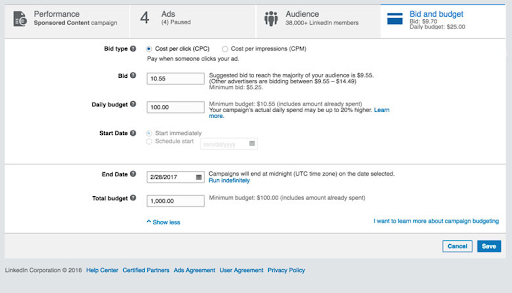
Paid advertisement bidding strategy (Source: LinkedIn)
After identifying the advertising objective, agents can select the audience they want to reach with the campaign. Agents have over 20 audience categories, like company size, member schools, groups, skills, and titles. Following the target audience is selecting an ad format. The ad formats on LinkedIn fall into different categories. Select from creating sponsored content, document ads, message ads, dynamic ads, and text ads to market your services.
Finally, agents must identify a budget and schedule for the advertising campaign. There are three price options to select from:
- Cost per send: The best option for a Message Ads campaign. You are charged for each message that is successfully delivered.
- Cost per click: Best pricing option for action-based campaigns like conversions or event registration.
- Cost per impression: Usually a good fit when brand awareness is your marketing objective. You’ll pay for each impression or view of your ad.
Once you choose the pricing structure, agents can identify a daily budget, start and end date, and total budget. Regardless of the campaign time frame, agents can cancel the campaign anytime. Paid advertising allows agents to reach professionals on the network they might not otherwise connect with through their various degrees of connection. With financials being an important role in buying or selling a home, the professionals on LinkedIn are most likely to be homeowners or in a financial position to purchase one. The right audience reach on LinkedIn can contribute to overall business growth.
8. Nurture Your Contacts Online & In-person
Nurturing your connections on LinkedIn is essential to developing deeper relationships. On LinkedIn, nurturing your contacts includes email, likes, comments, and messages. Sending direct messages to your contacts to congratulate them on their new role or related to one of their recent posts can help you build rapport. Liking or commenting on their posts can ensure you and your business stay top of mind.
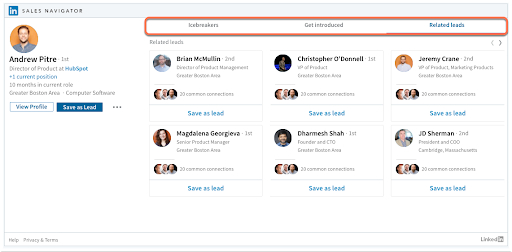
HubSpot integration with LinkedIn Sales Navigator (Source: HubSpot)
Although LinkedIn supports InMail, they don’t directly send emails to your connections to their third-party inboxes. However, you can export your contacts and their contact information to import into a customer relationship manager (CRM) to take your relationship to email marketing. CRM systems like HubSpot CRM have a LinkedIn integration. The integration helps pull in contact and company information like job title, location, industry, and company size into the CRM profile. Through the CRM platform, you can add the connection to an email drip campaign or even send InMail to stay top of mind.
LinkedIn Real Estate Statistics
For real estate agents, LinkedIn is an overlooked goldmine of leads. It is more than just a place to share your resume or connect with individuals in your network. When used correctly, LinkedIn can assist you in connecting with the appropriate group of people who will support the successful launch of your real estate business. So, we researched and gathered several statistics to help you better understand how to leverage LinkedIn to generate leads.
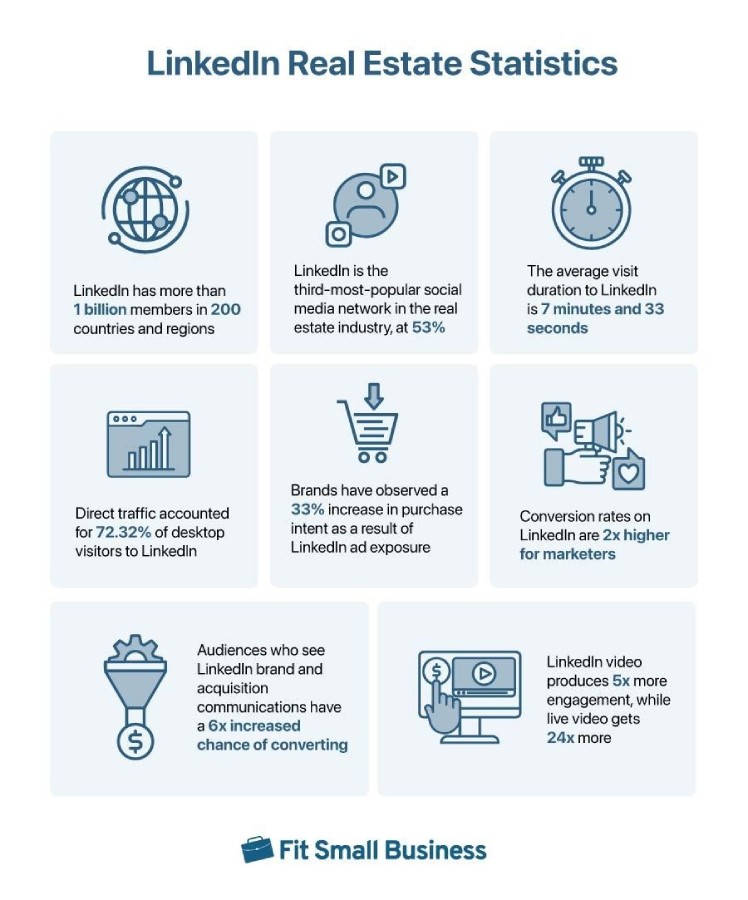
Here are a few important statistics on LinkedIn for realtors:
- LinkedIn has more than 1 billion members in 200 countries and regions
- According to the National Association of Realtors (NAR), LinkedIn is the third-most-popular social media network in the real estate industry, where 53% of realtors use it to generate leads.
- The average visit duration to LinkedIn is 7 minutes and 33 seconds.
- Direct traffic accounted for 72.32% of desktop visitors to LinkedIn last month, and organic search traffic came in second with 22.29% of visits.
- Businesses or brands have observed a 33% increase in purchase intent as a result of LinkedIn ad exposure.
- Conversion rates on LinkedIn are up to twice as high for marketers. Additionally, audiences who see LinkedIn brand and acquisition communications have a 6x increased chance of converting.
- On LinkedIn, video produces 5x more engagement, while live video gets 24x more.
Tips to Generate Real Estate Leads on LinkedIn
To effectively use LinkedIn to create a useful network, establish yourself as a leader in the field and generate high-quality leads. You can use the tips below to your advantage as a real estate agent on LinkedIn.
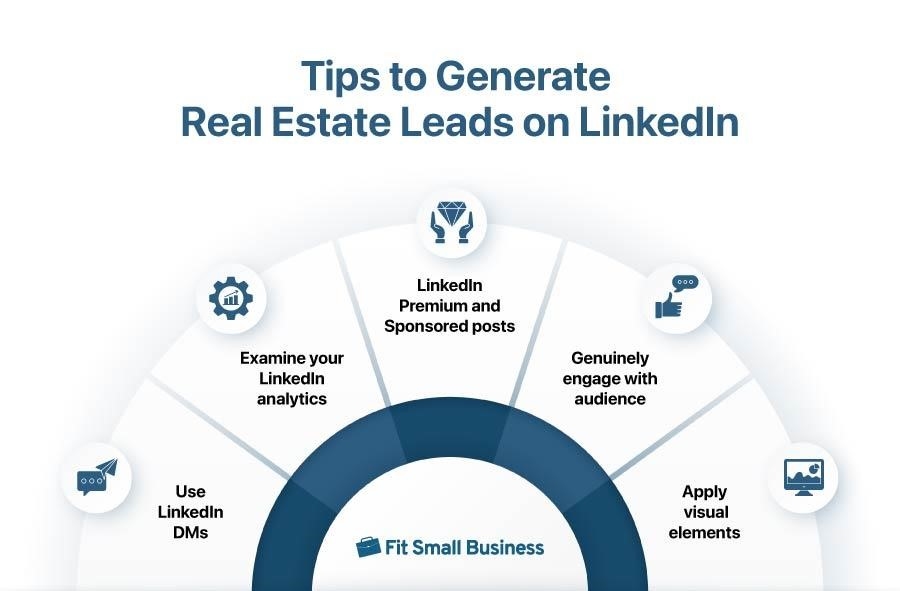
- Consider LinkedIn Premium and Sponsored posts. Reaching people who aren’t connected to you on LinkedIn can be easily done with the help of LinkedIn Premium and Sponsored postings. Promoting posts that are already performing well on their own is best as a sponsored post strategy.
- Examine your LinkedIn analytics to find out what is working and what isn’t. Use the analytics tools on the site to track links, clicks, impressions, and interactions with your posts, as well as what content and ads helped you acquire more followers. Analyze the patterns for your LinkedIn profile and adjust your real estate marketing strategies on the platform accordingly.
- Genuinely engage with your audience. You have to be active in the online community if you want your LinkedIn profile to garner attention. Apply comments, share, and like posts, but avoid appearing insincere or fake.
- Use LinkedIn DMs (direct messaging) to drive more leads to your contact database. Send a personalized introductory message or offer value in your initial message by sharing insights. Asking open-ended questions is also a great way to encourage them to reply.
- Make your posts entertaining with visual elements. A few examples are videos of client testimonials, live video tours of a property, real estate discussions, interactive maps, and statistics and market trends infographics.
Frequently Asked Questions (FAQs)
Real estate professionals use LinkedIn to capture and generate leads through the following ways:
- Establishing trust as a professional or real estate expert.
- Reconnecting with old contacts, alumni, workers, organization members, and friends.
- Asking for referrals from family and friends.
- Joining various LinkedIn real estate groups.
- Constantly posting and updating their profile and page.
- Utilizing direct mail campaigns, like sending InMail to followers.
Yes, using LinkedIn for real estate lead generation is an excellent strategy. According to Kyle Handy, LinkedIn has a high conversion rate, at 2.74% visitor-to-lead conversion rate1. While this doesn’t sound like much, it is substantially more than Facebook’s 0.77% conversion rate and Twitter’s 0.69% conversion rate. Also, HubSpot found that LinkedIn is 277% more effective than Facebook and Twitter for lead generation.
Yes, you can use LinkedIn to promote your real estate listing. You can share your listings in LinkedIn real estate groups to reach a wider audience.
Bottom Line
Since LinkedIn is mainly used for professional networking, you’ll be on a platform with professionals interested in learning about your services. After learning how to use LinkedIn for real estate leads, agents find it an excellent resource for generating organic and paid opportunities. By posting and engaging with other users on LinkedIn, you continuously build your professional network to create a sales funnel of prospective clients.
FAQ Resources: